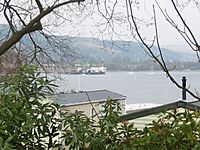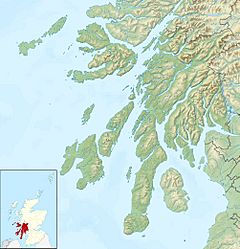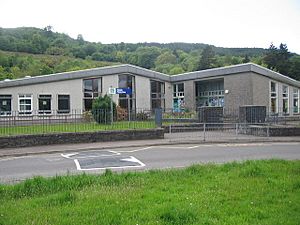Rosneath facts for kids
Quick facts for kids Rosneath
|
|
|---|---|
 View from caravan site at Castle Point, looking northwest across Rosneath Bay to the pier and village |
|
| Population | 1,260 (2020) |
| OS grid reference | NS 25447 83210 |
| Council area | |
| Lieutenancy area | |
| Country | Scotland |
| Sovereign state | United Kingdom |
| Post town | Helensburgh |
| Postcode district | G84 |
| Dialling code | 01436 |
| EU Parliament | Scotland |
| UK Parliament |
|
| Scottish Parliament | |
Rosneath (which means "promontory of consecrated ground" in Scottish Gaelic) is a small village in Argyll and Bute, Scotland. It is located on the western side of the Gare Loch. This is a narrow sea inlet that connects to the larger Firth of Clyde.
Rosneath is about 2 miles (3.2 km) northwest of the tip of the Rosneath Peninsula. It is also about 2.4 miles (3.9 km) by road from Kilcreggan. Kilcreggan is another village on the southern shore of the peninsula.
The Gare Loch becomes very narrow near Rosneath. This spot is called the Rhu Narrows. It is less than half a mile (about 600 meters) wide here. On the other side of the narrows is the village of Rhu.
South of Rosneath village, Rosneath Bay curves towards Castle Point. This area was once home to Roseneath Castle and Rosneath House. Today, a caravan park is located there. The coast then turns south to Rosneath Point. This point is at the very end of the peninsula.
Rosneath's Past
People have lived in the Rosneath area since at least the year 600. Around that time, St. Modan, a traveling missionary, started a church there. The name Rosneath likely comes from this period. It means "promontory of consecrated ground" in Gaelic.
The area was once heavily fortified with castles. Rosneath had its own castle, along with others nearby at Faslane and Shandon. These castles are no longer standing today.
Rosneath village as we know it did not exist back then. Instead, the area had many separate homes. For most of its history, people living here worked in farming and fishing. Regular shipping services to Glasgow and Greenock were very important for the local economy.
Rosneath Castle was destroyed and rebuilt many times. The last rebuilding happened between 1803 and 1806. This was after the previous building burned down. The new building was called Rosneath House. It was built in a Romanesque Revival style.
This grand house belonged to the Duke of Argyll. His family owned it until Princess Louise passed away in 1939. The house was located higher up the hill than the older castles.
From 1941 to 1945, Rosneath was home to an important naval base. This base was used by the Americans during World War II. The Gare Loch provided a safe, sheltered harbor for ships. Rosneath Castle was used as a base of operations. After the war, the castle was abandoned and torn down in 1961.
The Rosneath Peninsula used to be part of Dunbartonshire. However, in 1996, local government changes moved it into the Argyll and Bute council area.
How Many People Live in Rosneath?
In 2001, the population of Rosneath was 931 people. Rosneath is about 44 miles (71 km) from Glasgow by road. The village is located on the B833 road. This road runs along the shore of the peninsula.
Famous People from Rosneath
- John Anderson was an 18th-century scientist. He was born in Rosneath. His father was a minister at the local church. John Anderson later founded what became the University of Strathclyde.
- Moses McNeil was one of the people who started the first Rangers F.C. football team. He lived near Rosneath, in a place called Clynder. He was buried in the Old Churchyard of Rosneath in 1938. Rangers Football Club and local people have placed a plaque to mark his final resting place.
- Princess Louise, Duchess of Argyll was the daughter of Queen Victoria. She was the last person to live in Rosneath House.
- William de Bois Maclaren was a publisher and businessman. He was also a Scout Commissioner. In 1919, he bought Gilwell Park in Essex and gave it to The Scout Association.
See also
 In Spanish: Rosneath para niños
In Spanish: Rosneath para niños



